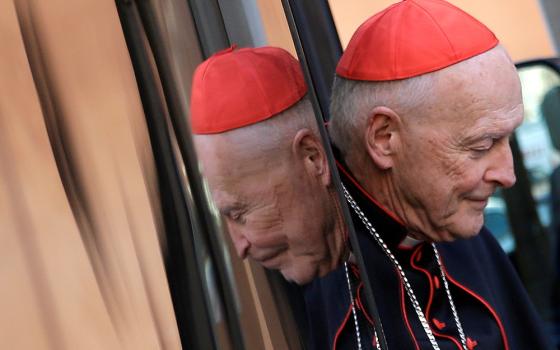Scholars do it.
Activists do it.
Even educated, justice-oriented parishioners do it.
No, Cole Porter fans, I’m not talking about falling in love, but rather falling fall prey to the internalized clericalism of the laity.
What else can explain the fact that many members of the Roman Catholic laity continue to give the clergy a pass after committing crimes that would easily bring down political powerhouses and tycoons of industry?
The latest tale of the mishandling of priestly sexual misconduct comes from the Kansas City-St. Joseph diocese. Exactly one year after the principal of a Catholic elementary school sent a letter of concern about the predatory behavior of Fr. Shawn Ratigan, the priest was arrested for possession of child pornography.
At issue is the fact that no diocesan official ever responded to principal Julie Hess’ concerns. It wasn’t until Ratigan attempted suicide in December -- seven months after Hess’ complaint was submitted -- that the priest was reassigned to a sisters’ community.
Kansas City Bishop Robert Finn admitted Friday that he did not read Hess’ letter, submitted May 19, 2010, until May 26, 2011 -- a week after Ratigan’s arrest.
Hess’ letter recounts over a dozen “red flag-raising” instances of the priest spending excessive time with children, inappropriately touching children and making children touch him. One father saw Ratigan rubbing circles in his daughter’s back. A mother found a pair of girl’s panties in a planter at the priest's home during a Brownie Girl Scout gardening.
The letter makes clear that Hess, as well as many teachers and parents, were very proactive not only in adhering to the diocesan guidelines for preventing sexual misconduct, but also in trying to keep the children away from the priest. Parents called their children away from him, and teachers quickly hovered near the priest when he approached the children too closely.
Their actions are commendable and one hopes that teachers and parents everywhere are modeling similar responses around suspected predators. However, I cannot help but note two troubling aspects of the story. First, it seems no one called the police. Second, parents, teachers, and school leaders did not make more noise and make greater demands for timely action. They waited and waited for a response from the chancery.
Obviously, I do not know every exact detail of what happened at that school over the past year. But this story, and the many others like it, left me wondering: if the predator in question were not a priest but were, instead, a teacher or coach, would parents and teachers have moved more quickly and aggressively to have the situation dealt with?
If parents found out that a public school superintendent, rather than a bishop, neglected to read a principal’s report about a teacher that had similarly sordid claims, would they not be relentless in calling for the superintendent’s resignation and prosecution of the teacher?
And yet, Ratigan was able to function freely as a priest for years, and Finn will likely emerge unscathed from the scandal.
The St. Patrick’s saga is but one example of the fascinating fear that many Catholics seem to have of calling church leaders to accountability the way they would elected officials, educators, and other non-clerical folk. This double standard that Catholics have in dealing with the clergy, I believe, is a result of the internalized clericalism that the laity inherited as part of their Catholic inculcation.
Critics of the institutional church frequently point to the corrosive arrogance of the Catholic clergy as the root cause of so much abuse of power. It is important, however, to consider the extent to which the clericalism of the laity enables these abuses to take place, and to reflect on the multitude of ways this phenomenon affects a spectrum of Catholics, including some of our most progressive voices.
I have seen the effects of lay clericalism among professors at Catholic colleges and universities, who fret about discussing controversial issues about gender and sexuality in an academic forum. Tenured scholars, who are exponentially more educated than most Roman Catholic priests, can quickly become terrified of the reactions of bishops to their academic programs.
I have seen lay clericalism in parishes considered “prophetic” because of their commitment to social justice, service to the poor, and welcoming of marginalized Catholics. And, yet, in many cases these progressive voices will not challenge the parish priest, even when he makes decisions that compromise a parish’s legacy of advocacy.
I know many lay women and men who have labored on parish staffs and have suffered the fruits of lay clericalism. Regardless of a lay minister’s education level, years of experience, and ministerial gifts, parishioners almost always have a submissive “preferential option” for the priest -- even if they disagree strongly with his policies and practices. A lay person’s degrees and pastoral presence are no match against the power of simply being “Father.”
So often it is the clericalism of the laity, rather than the clericalism of the clergy, that undermines the power of the laity in our church.
I am not a psychologist, but I know enough about human emotions to see that many Catholics still react to the institutional church as a damaged child would react to a punishing, authoritarian parent.
Though many have rejected the paternalism of church teachings, especially on issues of sexual morality, so many Catholics have not been able to wipe away the residue of experiencing the Catholic clergy as a disapproving parent, capable of banishing us from the love of God.
In the comments section of one of the NCR reports on the Ratigan case, several readers noted that Hess would surely be fired eventually for exposing both a predator priest and the mishandling of the case by a bishop who is a favorite of traditionalists.
Responding to this claim, an anonymous commentator, seemingly connected with St. Patrick’s, responded emphatically: “If this principal catches any grief over this[,] a full riot will occur at St. Pat's[.] I will help incite it. We will not let mis-conduct by the diocese punish our excellent school and its stellar leader.”
I pray that this person’s convictions will find support within St. Patrick’s lay community.
By risking their relationship with the institutional church in order to uphold a layperson of integrity, the laity of St. Patrick’s have the opportunity to join the growing ranks of Catholic communities that refuse to collude in the hierarchy’s abuse of power, like the administration of St. Joseph’s Hospital in Phoenix, Ariz.
As the tales of the institutional church’s deception and negligence continue to mount, lay Catholics must stop making themselves subservient to their imagined notions of the power of the hierarchy, and must instead allow themselves to be channels of the power of God that is made manifest through sacrifice, courage, and truthfulness.
They must recognize how their internalized clericalism may be impeding their prophetic participation in the Spirit’s unfolding work in our church.
[Jamie L. Manson received her Master of Divinity degree from Yale Divinity School where she studied Catholic theology and sexual ethics. Her columns for NCR earned her a first prize Catholic Press Association award for Best Column/Regular Commentary in 2010.]
| Editor's Note: We can send you an e-mail alert every time Jamie Manson's column, "Grace on the Margins", is posted to NCRonline.org. Go to this page and follow directions: E-mail alert sign-up. If you already receive e-mail alerts from us, click on the "update my profile" button to add "Grace on the Margins" to your list. |



